Medical Imaging Laboratory
Department of Biomedical Engineering, Yeditepe University
Medical Imaging Laboratory
Department of Biomedical Engineering, Yeditepe University
Supervised Research Projects
T1 Estimation of Brain Metabolites for Phosphorus MR Spectroscopic Imaging at 3T (Safa Demirkan)
This study estimated T1 relaxation times for phosphorus containing metabolites of the brain at 3T. T1 estimation is fundamental to estimate correct metabolite intensities due to signal saturation that happens with short TR. Four 1D 31P spectra were acquired with ISIS and an inversion recovery sequence. The peak parameters estimated using AMARES were used to reconstruct the time domain signal, and T1 relaxation times of each metabolite were fit into the inversion recovery equation in MATLAB. The resultant T1 values were used in calculating saturation factors for a more accurate spectral quantification of 31P MRS at 3T.
Compressed Sensing for Fast Magnetic Resonance Imaging (Berna Atis)
Compressed sensing (CS) is a parallel imaging method that has been used to reduce MR scan time. This algorithm solves the image reconstruction problem of randomly undersampled MR data. CS needs three criteria to be applicable. The first one is that the signal should be sparse in a transform domain. Second, the signal should be randomly undersampled resulting in an incoherent aliasing pattern. Third, a nonlinear data reconstruction method, like conjugate gradient method, that aims to find an approximate solution for an ill-posed problem, should be used. In this project, a MATLAB GUI was designed to implement different subsampling methods. The effects of different subsampling patterns in compressed sensing image reconstruction were observed. For the CS algorithm, some reconstruction parameters, which were total variation weight, Wavelet weight and Wavelet size were optimized.
T2 Mapping of Knee Cartilage at 3T (Ersin Uzmen)
The transverse relaxation time (T2) of cartilage has been proven useful for early diagnosis of articular cartilage degeneration. This technique also gives information about cartilage water content and collagen structure and organization. T2 values of cartilage have been observed to be higher and more heterogeneous in patients diagnosed with osteoarthritis in comparison to normal volunteers. In this study, MR images of the knee were obtained in healthy volunteers. Turbo spin echo (TSE) technique with SENSE was used to obtain MR images at 6 different echo times in less than 10 minutes. T2 mapping of the cartilage tissue was obtained from the resultant images. Our T2 maps were similar to the maps previously reported in the literature. The result of this study has been shared with the radiologists and orthopedicians for its clinical usage.
Analyzing Hand Movement in FMRI Data of Brain Tumors using FSL (Nurten Ceren Askin)
Functional magnetic resonance (fMRI) is a powerful non-invasive tool in study of neuroimaging. Since its introduction in 1992 fMRI has grown explosively to become a standard and compulsory tool in neuroscience research. fMRI provides the ability to image regions of altered neuronal activity in human brains. fMRI allows the study of how the healthy brain functions, how it is affected by different diseases, how it efforts to recover after damage and how drugs can modulate activity or post-damage recovery. In this project, the motor area activations due to right hand movement is analyzed for eleven patients diagnosed with brain tumors. fMRI data was analyzed using FMRIB’s Software Library (FSL). General linear modeling (GLM) based analysis was performed to obtain activation maps on the left side of the primary motor cortex of the patients, and the shift of hand movement area due to tumor has been observed.
3D Modeling of Hip Bones from CT Images in MATLAB (Esra Arifoglu)
CT is a medical imaging technique which can depict multiple slices of the body by acquiring X-ray images in multiple angles, and backprojecting the data. In this project, multiple views of the hip bone from CT images were processed. Thresholding, median filtering, edge detecting, and region growing were implemented in a MATLAB Graphical User Interface (GUI). The major benefit of this project was to identify the bone structure properly for possibly creating an implant.
SPM Analysis of fMRI Data of Hand Movement in Brain Tumor Patients (Berfu Bilir)
Functional magnetic resonance imaging (fMRI) can be used to map activation patterns in the human brain by modeling blood oxygenation level dependent changes. In this project, fMRI data of right hand movement was analyzed for brain tumor patients using Statistical Parametric Mapping (SPM), which is a software package in MATLAB. General linear modeling (GLM) based analysis was performed to obtain activation maps. The resultant activation maps of patients were overlayed on their respective T1 weighted structural images. Activation was observed on the left primary motor cortex of patients.
Brain white matter segmentation from T1 weighted MR images (Serdar Teke, co-advisor: Assoc. Prof. Cem Unsalan)
In this project, segmentation of various regions from MR images of the brain was executed. The main problem in segmenting these regions was that intensity values of different neighboring tissues are very similar in an MR image. Therefore, two types of image filtering techniques which are bilateral and median filtering were applied before segmentation procedure. Multi-thresholding was used as a segmentation method after filtering procedure. Image eroding was executed to remove irrelevant regions usually appearing as little dots after segmentation. As a result, multi thresholding process after bilateral filtering was more successful in differentiating regions in an MR image than after median filtering was applied. However, median filtering might be useful before segmentation process as it is computationally faster than bilateral filtering.
GAMMA Simulations for GABA Editing in the Brain using J-PRESS (Melis Kurdoglu)
Magnetic resonance spectroscopic imaging (MRSI) can be used in the diagnosis of brain tumors, epilepsy and metabolic disorders. In this project, Gamma-Amino Butyric acid (GABA) editing using J-PRESS and TE-Averaged PRESS was examined by using general approach magnetic resonance mathematical analysis (GAMMA) simulation. GABA metabolite level changes in brain diseases was studied.
3D Modeling of Knee Joint from CT Images in MATLAB (Gozde Tugcu)
CT imaging can generate cross sectional views of body organs and tissues. In this project, multiple CT DICOM images of the knee bone were analyzed. A MATLAB GUI was designed to segment knee bone using thresholding, followed by median filtering, edge detection, and region growing.The main aim of this project was to specify the bone structure properly for possibly making implants.
GAMMA Simulations of Brain Metabolites using TE-Averaged PRESS (Ugur Minkar)
MRSI detects the concentration of biologically important cellular and extra-cellular compounds. TE-Averaged PRESS can better visualize J- coupled metabolites of glutamate, glutamine, and myo-inositol in the brain. In this study, TE-Averaged PRESS spectra of brain metabolites were simulated in GAMMA. The simulation results at TE=35 ms looked very similar to spectra reported in Govindaraju’s paper. The results of this study will be used for acquiring better MR spectroscopic data of multiplet peaks in human brain.

Magnetic Resonance Spectroscopy of Spine at 3T (Uğur Yurttaş )
A MATLAB graphical user interface for magnetic resonance spectroscopy (MRS) of spine was designed. MR spectroscopy data of 5 different subjects were examined with this software. Lorentzian and Gaussian filtering, phase correction, and peak parameter estimation were implemented. Proteoglycan (PG) and water contents were estimated.

Mammography has a major importance in breast cancer diagnosis. In this study, a MATLAB graphical user interface was designed to analyze mammography phantom images to test the calibration of a mammography device. A passing score was given if 4 fibers, 3 calcification groups and 3 masses were visible.
Design of a Graphical User Interface for a Statistical Data Analysis Tool in MATLAB (Ceren Artuner)
Biostatistics is an important component of writing a research article. In this project, a graphical user interface was designed in MATLAB that can perform a variety of biostatistical tests such as ANOVA, unpaired t test, chi-square test, multiple comparison tests (Bonferroni t test, Holm t test, SNK test, Tukey test), McNemar’s test, z test, paired t test, Wilcoxon signed rank test, Mann-Whitney ranksum test, Pearson product moment correlation, relative risk and odds ratio, Spearman rank correlation, and Friedman statistics. This graphical user interface was named as ‘EasyBiostatistics’.
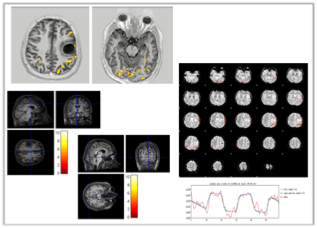
In this study, speech activation functional magnetic resonance imaging (fMRI) data obtained from nine patients diagnosed with a brain tumor at Department of Radiology at Yeditepe University Hospital were used. The data were processed by using Statistical Parametric Mapping (SPM) and FMRIB Software Library (FSL), and the results were compared with the activation maps that were obtained by the Philips ViewForum software. The areas in the brain where the speech activations occured were observed. The dominant hemisphere of the patients for speech, and if they have any aphasia was determined.The speaking activity of humans is mainly controlled by the Wernicke’s and Broca’s areas in the brain, and observation of the activations in those areas were aimed. The results obtained by SPM and FSL were similar to the Philips ViewForum software results. The end goal of this study was to evaluate SPM and FSL, which are both freeware, for providing Neurosurgeons the speech activation area maps in the brain to avoid any possible harm to the patients’ speech during surgery.

Arterial spin labeling (ASL) magnetic resonance imaging can measure cerebral blood flow without using any kind of radioactive or contrast agents. Arterial spin labeling MRI can track the movement of blood in the brain. In ASL, first, a control image is acquired. Next, spins are tagged at carotid artery level, and then the same slice is acquired after some inversion time. The difference of these two images is then fit into a model to solve for cerebral blood flow. Cerebral blood flow often increases in brain tumors, which can then be detected using the ASL technique. In this project, a MATLAB graphical user interface (GUI) was designed to analyze arterial spin labeling MR images to generate cerebral blood flow maps.

Magnetic Resonance Spectroscopy of Breast Cancer at 3T (Dilay Kayış)
Magnetic resonance spectroscopy (MRS) might play a role in breast cancer diagnosis by detecting an increase in choline peak. In this project, a MATLAB GUI was designed that would analyze MR spectrum of breast cancer acquired at 3T. The program was capable of Lorentzian and Gaussian filtering, and phase correction. Afterwards, peak heights of choline, lipid and water peaks were estimated.

Magnetic resonance spectroscopic imaging (MRSI) helps to obtain three dimensional metabolic information of biological compounds. In this study, MRSI data obtained from a brain tumor patient was used. A data processing software was designed in MATLAB in order to process spectra. The spectra were apodized with a Lorentzian or Gaussian filter, and phase of the spectra was corrected. The frequency ranges of the peaks were entered in order to calculate the peak height, peak area, and signal to noise ratio (SNR) of choline, creatine, N-acetyl aspartate (NAA), lipid and water. The minimum, maximum, median, mean and standard deviations of related peaks were written out as different tables. In addition, choline/NAA and creatine/NAA peak ratios were calculated and shown as color maps on the brain for tumor localization purposes.
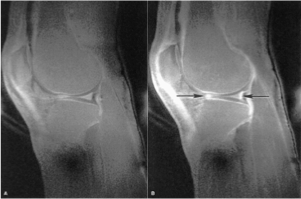
Tissues that contain short T2 components are poorly detected with conventional magnetic resonance imaging sequences. These components are the majority of the species in tendons, ligaments, menisci, periosteum, cortical bone and other related tissues. Ultra short echo time (UTE) pulse sequences have been employed for detection of short T2 components. UTE techniques have reduced the limit of echo time (TE) for clinical detectability of short T2 components by about two orders of magnitude from about 10 ms to 100 µs. In this project, a literature review was prepared for ultra short echo time MR imaging.
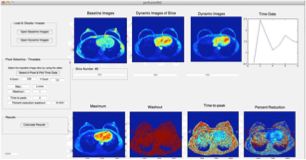
T1 Weighted Perfusion Magnetic Resonance Imaging of Breast Tissue at 3T (Ecem Şahin)
In this project, a MATLAB GUI was designed to guide the physicians in detecting malignant masses in the breast tissue. The program was able to post-process the T1 weighted dynamic contrast-enhanced MR images acquired by using e-THRIVE sequence at 3T. The data of four patients scanned at Department of Radiology at Yeditepe University Hospital were used. The intensity parameters of the time curve, which were the maximum, washout, time to peak, and percent reduction, were estimated for each pixel selected by the user.
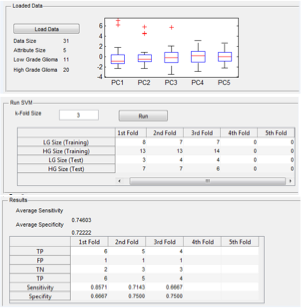
Support Vector Machine for Brain Tumor Classification Using Multiparametric MRI (Rüştü Taşkan)
In this project, multiparametric MRI data of thirty-one brain tumor patients were classified as low or high grade by using support vector machine method. Support vector machine (SVM) algorithm was developed in MATLAB and a graphical user interface (GUI) was designed to show the sensitivity and specificity values of the algorithm. The results were calculated by k-fold validation technique.
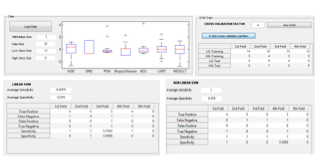
Support Vector Machine Based Prediction of Final Gleason Score Using Multiparametric Prostate MRI (Özge Mansuroğlu)
In this project, the Gleason scores of twenty-two prostate cancer patients were evaluated and classified by using their MRI data. The main goal of the project was to help early diagnosis using an automated classification algorithm. For classification, support vector machine was used which is a machine learning method. SVM algorithm was designed by using MATLAB and a Graphical User Interface (GUI) was developed for the algorithm. The attributes of data were shown in Whisker-box plots. Sensitivity, specificity and their average values were calculated by using k-fold validation technique and the results were shown in the GUI.

The aim of this project was to determine the grade of a glioma by using multiparametric brain MR imaging. The data set were included diffusion weighted MR imaging, diffusion tensor MR imaging, perfusion weighted MR imaging and MR spectroscopic imaging. Low and high grade gliomas were classified by using artificial neural network which is a machine learning method. Principal component analysis was used to adjust the data size. ANN algorithm was implemented in MATLAB and the results of ANN iterations were shown in a graphical user interface. The sensitivity and specificity values were calculated according to the classification results and these values were also shown in the GUI.
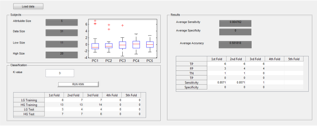
In this project, k-nearest neighbor algorithm was used for classification of glioma grade. MRI data from thirty-one patient were used, and MATLAB was utilized in the implementation of k-nearest neighbor classifier (KNN), and a graphical user interface was developed for the classification task. The sensitivity, specificity, and accuracy values of the classifier were computed to understand the success of the classification.

Resting-State Functional Magnetic Resonance Imaging of Human Brain at 3T (Buse Aygen)
Resting-state functional magnetic resonance imaging (rs-fMRI) is a more recent MR imaging technique to determine the activation spots in the brain during no task to understand functional connectivity between brain areas. The networks in the brain can be defined with rs-fMRI and analyzed by two methods, which are seed-based functional connectivity and independent component analysis. In this study, the resting state functional magnetic resonance imaging data of five subjects were analyzed. First, motion correction was applied by using SPM8 Software and the data were examined by using GIFT Software with ICA technique and the areas that are active were determined. Previously determined activation regions were compared with the results of this study. Similar activation areas were found with the previous findings.

‘There is nothing that nuclear spins will not do for you as long as you treat them as human beings.’
Erwin Hahn